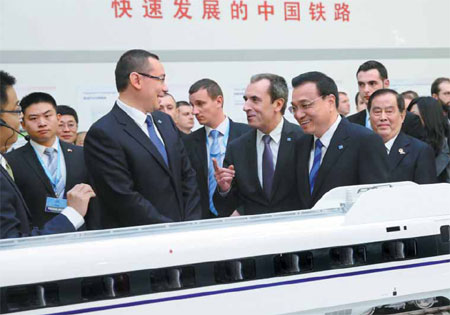China taken on as building partner
Updated: 2013-11-29 10:29
By Zhao Yinan, Li Xiaokun, Zhou Wa and Fu Jing (China Daily Europe)
|
|||||||||||
Meetings with central and Eastern European heads underline China's global roal
Common economic prosperity and collaboration with Central and Eastern European countries will set the stage for China's bilateral and multilateral relations in Europe, experts say. By indicating that CEE would be an important cog in its economic diplomacy, Chinese leaders, led by Premier Li Keqiang, have demonstrated that they are committed to balanced development and better political trust. At the same time, a meeting of Chinese and CEE leaders in Bucharest further underlined China's growing importance in global affairs and its role in shaping the global economic recovery.
Evidence of China's new global role was seen in a flurry of meetings that Li had with 15 prime ministers and one foreign minister from the 16 CEE countries on the sidelines of the China-CEE leader's meeting in Bucharest, Romania. The 16 CEE countries are: Albania, Bosnia and Herzegovina, Bulgaria, Croatia, the Czech Republic, Estonia, Hungary, Latvia, Lithuania, Macedonia, Montenegro, Poland, Romania, Serbia, Slovakia and Slovenia.
With 2014 being designated as an 'investment promotion year' by both sides, and several big-ticket events planned, it is clear that the diplomatic efforts are also in line with China's commitment to deepen reforms.
"Central and Eastern Europe is a major emerging market in which there are several medium and long-term prospects," says Cui Hongjian, director of European studies at the Beijing-based China Institute of International Studies.
He says the China-CEE alliance is a good fit, as the CEE needs overseas investment to improve infrastructure, transport and energy sectors. On the other hand, China is looking for newer destinations to channel its overseas investment.
"If both sides can seize the resulting opportunities, there is no doubt that economic cooperation will blossom," Cui says.
Bucharest agenda
In one of the major guidelines adopted at the Bucharest meeting, leaders from both sides agreed to encourage small and medium-sized enterprises in such a manner that they can play a more active role in economic and trade cooperation between the two sides.
Other major decisions included the plan by China and the CEE countries to double bilateral trade volumes in five years and set up a new railway link between the two sides.
Speaking in Bucharest, Li said China will take measures to further boost trade with the CEE countries by hosting round-table meetings with commerce ministers, exhibiting the region's products in China and by holding agricultural and trade forums.
He also called on China and the region to work together on a series of major infrastructure developments such as railway and power projects. A special exhibition featuring Chinese equipment involved in high-speed railway and infrastructure construction was held during the meetings in Bucharest.
In a room of more than 200 square meters in the Romanian parliament, a large LED panel was set into a wall. The eye-catching exhibits included two train models - one of a high-speed railway and one of an ordinary railway - placed in the center of the room.
Li said the exhibition is to let the governments and businesses in Central and Eastern European countries know more about the development of Chinese infrastructure and encourage companies from both sides to invest in fields in which they can complement each other.
Li also announced that China, Hungary and Serbia would jointly build a railway connecting the Hungarian capital Budapest and the Serbian capital Belgrade.
The Hungary-Serbia railway project is the second railway construction project signed by China after it teamed up with Romania for a high-speed railway line.
Li said the projects have great significance for infrastructure collaboration between China and the European countries. He highlighted the large potential in China's cooperation with the region in infrastructure, electricity and construction projects, especially the high-speed railway system.
China now boasts the world's second-longest ordinary railway network and the longest high-speed railway network.
"Infrastructure cooperation with Central and Eastern European countries is a good way to help China carry out its policy of export restructuring," says Zhao Junjie, a researcher on European studies at the Chinese Academy of Social Sciences.
"The construction of Romania's high-speed railway is a good example of China's high-tech prowess in the infrastructure industry, and one that will attract more alliances," he says.
Zhao says that most of the Central and Eastern European countries lack the necessary technology and equipment, and this in turn creates a window of opportunity for Chinese companies.
China has undertaken several infrastructure projects in Eastern European countries, including building Serbia's Belgrade bridge over the Danube River, which started in 2010, and the newly launched Stanari power plant project in Bosnia and Herzegovina.
"China can enlarge its influence in the area by executing major infrastructure projects and selling its equipment. Such cooperation can also increase the political trust between China and the region," Zhao says.
Trade factor
Trade volumes between China and the EU reached $546 billion (405 billion euros) last year, the best among China's trade partners. However, China's manufactured products have faced several anti-dumping duties imposed by European countries, affecting various industries from ceramics to photovoltaic products.
"It's the right time for China to increase exports of equipment and technology because such trade is unlikely to arouse anti-dumping duties compared with manufactured products," Zhao says.
He Maochun, director of the Economy and Diplomacy Research Center at Tsinghua University, says the change in China's export structure coincides with restructuring of the country's economy.
"China's heavy industries are developing fast, requiring the country to increase exports of equipment and infrastructure. Each exploration of the overseas market can pave the way for the further development of China's industry."
Analysts say the potential for trade between China and Central and Eastern Europe is huge.
In the first 10 months of the year, trade between China and Central and Eastern European countries reached $52.1 billion. The figure surpassed the $50 billion recorded in 2012, but accounted for only 10 percent of trade between China and the European Union.
While Chinese investment in Central and Eastern Europe topped $800 million in 2010, compared with almost nothing in the early 2000s, the region attracted less Chinese investment than in Sweden alone, according to the Central and Eastern European Development Institute in Warsaw.
"Increasing trade and investment is essential for both China and Central and Eastern European countries," says Pan Zhanlin, former Chinese ambassador to the former Yugoslavia.
"Central and Eastern Europe is eager to attract more foreign investment and to increase exports to boost its economies and tide over the negative impact of the international financial crisis," Pan says.
Wider EU impact
Cooperation with China can help them better diversify their sources of investment, while China's huge market brings them huge opportunities. Central and Eastern Europe will also be an important agricultural product supplier to China, Pan says.
China's urbanization will bring greater demand for beef, lamb, cheese, wines and other products.
Camelia Sucu, a Romanian businesswoman, says she invested in agriculture four years ago because of the outlook for the industry. Sucu's company, which owns about 2,000 hectares of farmland, plans to export beef to China.
Premier Li's promise to import more beef and lamb from Romania has made her believe that the idea of exporting safe agricultural products to China can bring good business, she says.
Analysts say that closer ties with the region will enrich cooperation between China and all of Europe.
Xing Guangcheng, a researcher at the Chinese Academy of Social Sciences, says that China's closer ties with the region will help boost links in Europe.
"China is building a complete framework for economic collaboration with all of Europe."
Central and Eastern Europe occupies about 1.3 million square kilometers, about one-third of the continent. The region's population is put at about 123 million. Compared with countries elsewhere in Europe, Central and Eastern Europe has its own characteristics in economic and social development.
Cui, the researcher with the China Institute of International Studies, says: "Cooperation with these countries will effectively complement China-EU cooperation. It shows a strategic coordination of the current China-EU system of cooperation.
"Cooperation with China will help Central and Eastern European countries improve the level of infrastructure construction, and therefore their connectivity with other parts of Europe."
China has accelerated its cooperation with the region in recent years, launching the Secretariat for Cooperation between China and Central and Eastern European Countries in September last year.
A $10 billion special credit line is also operational and China has sent more than 30 trade promotion delegations to the region.
Balanced policy
"From Premier Li's various engagements (with Europe) we can see that China is trying to implement an active and balanced policy toward Europe," says Shada Islam, policy director of the think tank Friends of Europe in Brussels.
Islam says China's new leaders have shown that they are interested in developing closer ties with Europe and have identified areas of practical cooperation with an emphasis on urbanization. "These are good steps forward and should be followed up with efforts by both sides to foster better understanding of each other and building trust," Islam says.
The 16th China-EU Summit held in Beijing recently came out with the China-EU 2020 Strategic Agenda for Cooperation and China signed several agreements with the 28-country bloc.
The summit announced the launch of negotiations on a China-EU investment agreement and set the goal of raising China-EU trade to $1 trillion by 2020.
Li's visit to Central and Eastern European countries will help realize the ambitious goal from the new EU-China 2020 strategic agenda to almost double Sino-European trade volume from $580 billion in 2012 to $1 trillion by 2020, says Philip Koch, consultant for China affairs at the Hamburg Chamber of Commerce in Germany
"The goal is that the EU and China maintain extraordinary economic relations," Koch says.
Koch says this economic interdependence needs closer political ties. "Therefore, the European Union is a key strategic partner for China as well."
Besides economic benefits, China's ties with CEE countries can also increase political trust between China and Europe.
Zhao from the Chinese Academy of Social Sciences says: "It's not only an important chance for the regional countries to boost their economies with China's help, but also an opportunity for China to deepen communications and understanding with Europe and build bilateral relations at various levels."
Analysts say Li's trip should also be viewed through the prism of the reform-setting Third Plenum.
His visit is the first European trip by a state leaders after the plenum.
"At a moment when China has just rolled out reform initiatives for the next decade and is determined to open its market to the world, relations with countries in Central and Eastern Europe as well as Central Asia can benefit all sides," says Zhou Yongsheng, professor of international relations at China Foreign Affairs University.
The key Party meeting that concluded in November pledged more openness to global markets and foreign businesses.
The document issued after the meeting said restrictions on overseas investors are to be lifted for industries that include services for children and the elderly, architectural design, accounting and auditing, commerce, logistics and e-commerce. Industries that will open up gradually for investors include financial services, education, culture and medical care, while opening-up of the manufacturing sector will be increased.
"Central and Eastern European countries are understandably very interested in energy cooperation and infrastructure development, which can accelerate their industrialization objectives," says Dan Steinbock, research director of International Business at the India, China and America Institute.
"Conversely, such efforts are multilaterally well-aligned with China's new reforms and opening-up policies."
Contact the writers through zhaoyinan@chinadaily.com.cn
|
Chinese Premier Li Keqiang and leaders from Central and Eastern European countries view a model of a Chinese high-speed train at an exhibition of Chinese equipment in Bucharest, the Romanian capital, on Nov 26. Yao Dawei / Xinhua |
(China Daily European Weekly 11/29/2013 page6)
Today's Top News
Cameron to arrive with big delegation
China launches moon rover
Honor Cairo Declaration
34th high-speed railway starts
Testing time for China's tea growers
8 dead in police helicopter crash onto Glasgow pub
Xi stresses fight against HIV
Premier's trips bear fruit
Hot Topics
Lunar probe , China growth forecasts, Emission rules get tougher, China seen through 'colored lens', International board,
Editor's Picks

|

|

|

|

|

|





